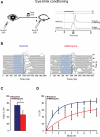Anti-malaria drug mefloquine induces motor learning deficits in humans
- PMID: 21151372
- PMCID: PMC2996171
- DOI: 10.3389/fnins.2010.00191
Anti-malaria drug mefloquine induces motor learning deficits in humans
Abstract
Mefloquine (a marketed anti-malaria drug) prophylaxis has a high risk of causing adverse events. Interestingly, animal studies have shown that mefloquine imposes a major deficit in motor learning skills by affecting the connexin 36 gap junctions of the inferior olive. We were therefore interested in assessing whether mefloquine might induce similar effects in humans. The main aim of this study was to investigate the effect of mefloquine on olivary-related motor performance and motor learning tasks in humans. We subjected nine participants to voluntary motor timing (dart throwing task), perceptual timing (rhythm perceptual task) and reflex timing tasks (eye-blink task) before and 24 h after the intake of mefloquine. The influence of mefloquine on motor learning was assessed by subjecting participants with and without mefloquine intake (controls: n = 11 vs mefloquine: n = 8) to an eye-blink conditioning task. Voluntary motor performance, perceptual timing, and reflex blinking were not affected by mefloquine use. However, the influence of mefloquine on motor learning was substantial; both learning speed as well as learning capacity was impaired by mefloquine use. Our data suggest that mefloquine disturbs motor learning skills. This adverse effect can have clinical as well as social clinical implications for mefloquine users. Therefore, this side-effect of mefloquine should be further investigated and recognized by clinicians.
Keywords: cerebellum; eye-blink conditioning; gap junctions; mefloquine; motor behavior.
Figures




Similar articles
-
Microcircuitry and function of the inferior olive.Trends Neurosci. 1998 Sep;21(9):391-400. doi: 10.1016/s0166-2236(98)01310-1. Trends Neurosci. 1998. PMID: 9735947 Review.
-
Eye disorders reported with the use of mefloquine (Lariam(®)) chemoprophylaxis--A drug safety database analysis.Travel Med Infect Dis. 2015 Sep-Oct;13(5):400-8. doi: 10.1016/j.tmaid.2015.04.005. Epub 2015 Apr 30. Travel Med Infect Dis. 2015. PMID: 26119539
-
Carbenoxolone and mefloquine suppress tremor in the harmaline mouse model of essential tremor.Mov Disord. 2006 Oct;21(10):1641-9. doi: 10.1002/mds.20940. Mov Disord. 2006. PMID: 16773639
-
Absence of associative motor learning and impaired time perception in a rare case of complete cerebellar agenesis.Neuropsychologia. 2018 Aug;117:551-557. doi: 10.1016/j.neuropsychologia.2018.07.021. Epub 2018 Jul 18. Neuropsychologia. 2018. PMID: 30031016
-
Mefloquine for malaria chemoprophylaxis 1992-1998: a review.J Travel Med. 1999 Jun;6(2):122-33. doi: 10.1111/j.1708-8305.1999.tb00843.x. J Travel Med. 1999. PMID: 10381965 Review.
Cited by
-
A small-fish model for behavioral-toxicological screening of new antimalarial drugs: a comparison between erythro- and threo-mefloquine.BMC Res Notes. 2015 Apr 2;8:122. doi: 10.1186/s13104-015-1088-x. BMC Res Notes. 2015. PMID: 25886204 Free PMC article.
-
Complex Membrane Channel Blockade: A Unifying Hypothesis for the Prodromal and Acute Neuropsychiatric Sequelae Resulting from Exposure to the Antimalarial Drug Mefloquine.J Parasitol Res. 2015;2015:368064. doi: 10.1155/2015/368064. Epub 2015 Oct 20. J Parasitol Res. 2015. PMID: 26576290 Free PMC article. Review.
-
A novel eyelid motion monitor.Graefes Arch Clin Exp Ophthalmol. 2017 Sep;255(9):1811-1817. doi: 10.1007/s00417-017-3712-z. Epub 2017 Jun 16. Graefes Arch Clin Exp Ophthalmol. 2017. PMID: 28623400
-
An Internal Focus Leads to Longer Quiet Eye Durations in Novice Dart Players.Front Psychol. 2016 May 2;7:633. doi: 10.3389/fpsyg.2016.00633. eCollection 2016. Front Psychol. 2016. PMID: 27199860 Free PMC article.
-
Behavioral correlates of complex spike synchrony in cerebellar microzones.J Neurosci. 2014 Jul 2;34(27):8937-47. doi: 10.1523/JNEUROSCI.5064-13.2014. J Neurosci. 2014. PMID: 24990915 Free PMC article.
References
-
- Baudry S., Pham Y. T., Baune B., Vidrequin S., Crevoisier C., Gimenez F., Farinotti R. (1997). Stereoselective passage of mefloquine through the blood–brain barrier in the rat. J. Pharm. Pharmacol. 49, 1086–1090 - PubMed
LinkOut - more resources
Full Text Sources
Other Literature Sources
Miscellaneous

